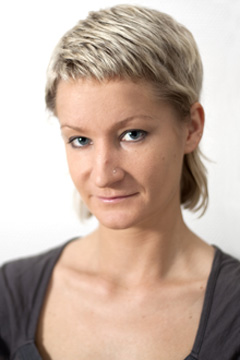Vera Lapitskaya: The duet piece by Ann Van den Broek for one male and one female dancer creates an agonizing atmosphere of a couple relationship world, where the characters express their feelings to each other avoiding any possible touch. The choreographer was able tell the story about a man and a woman avoiding any body contact between them, which is quite uncommon for these type of duet pieces.
Heini Tuoresmäki: I Solo Ment -teoksessa liikkeiden merkitys konkretisoitui ja näyttäytyi kirkkaasti. Ihmiset paljastettiin säästelemättä, ja tanssijat kulkivat läpi ihmissuhteiden satunnaisen kompleksisuuden. Riipaisevaa oli myös se, että mies ja nainen eivät olleet täydellisesti uppoutuneita vain itseensä, vaan he anoivat katseita yleisöltä ja pyrkivät herättämään kiinnostuksen. Toisiinsa he eivät kuitenkaan saaneet mitään kontaktia, ja sitä oli hetkittäin vaikea katsoa.
I SOLO MENT
Konsepti ja koreografia / Choreography and concept: Ann Van Den Broek
Tanssijat / Dancers: Dario Tortorelli, Cecilia Moisio
Sävellys / Composition: Arne Van Dongen
Musiikin editointi / Music editing: Arne Van Dongen, David Van Bouwel
Lavastus / Stage design: Niek Kortekaas
Video ja valosuunnittelu / Video and lighting design: Bernie van Velzen
Tuotanto / Production: Korzo producties (Haag)
Yhteistuotanto / Coproduction: Ward/waRD vzw (Antwerpen), CC Berchem (Antwerpen)
Sivuaskel / Side Step Festival 2010, Zodiak, Helsinki
I Solo Ment
The duet piece by Ann Van den Broek for one male and one female dancer creates an agonizing atmosphere of a couple relationship world, where the characters express their feelings to each other avoiding any possible touch. The choreographer was able tell the story about a man and a woman avoiding any body contact between them, which is quite uncommon for these type of duet pieces. The world the dancers exist in reminds the audience of the frames of a black and white photo film, where the scenes are changing with the flash of an invisible photo camera.
The relationship between the characters doesn’t look promising nor optimistic from the very first part of the piece. It starts with a scene of death, in which the female dancer moves the dead body of her untouchable and, in a way, invisible partner. And from the very beginning of the piece, the interactions between the dancers without having a proper physical contact become admirable by the precision with which they both move. It looks like the body of Dario – the male dancer – has invisible strings through which Celia – the female dancer – manipulates him while he is lying on the floor…
The character of Dario seems to be a strong introvert, who is stuck with his own thoughts and the world he lives in. He seems to be absolutely closed off from the outside world as well as from the world of his untouchable partner Cecilia. In her turn, the character of Cecilia seems to be more curious and open. Though she also exists in here own world, at the same time she supports and observes the world which Dario lives in. Sometimes she turns into the reflection of Dario, following all his movements and gestures and even the expression of his face, but sometimes she gets back to her own, forgetting about the person who exists nearby. This idea is supported by the shift from the separate solo dancing to the extremely precise unison dance, and this shift is truly admirable. At times, the unison is so precise that even the eyes of the dancers are moving equally and looking at the same spot! It also amazing how precisely the dancers move in the space. How do they manage to make quite rapid movements towards each other but then to stop just a few centimeters away from each other avoiding the touch which would be so foretasted by the audience.
The strongest scene of the untouchable relationship is the scene with the fight between the couple when it is obvious that the man is punching and hurting the woman despite the fact that he is staying far from her. Both partners stay separate from each other in the space but at the same time they are strongly connected through their movements. The body of Cecilia reacts to every single action of Dario the way as she would be in a close body contact with him. And the intention they both move with, in addition to the extreme emotionality, makes the audience be truly absorbed by the atmosphere of their cruel untouchable fight.
Another interesting and attention-drawing thing is the use of the daily life gestures in the choreography. Seems that one of the methods the choreographer uses to create movement material for her pieces is partly based on that. In the piece Co(te)lette which was shown in Zodiak in the autumn 2009, the use of the daily life gestures was even more obvious and essential than in «I solo ment». This approach to the movement definitely makes the movement itself more versatile, but on the other hand more understandable and recognizable for the audience. It also builds up firmer bridges between the ideas and stories of the choreographer on one hand and the audience on the other.
 Vera Lapitskaya is a choreographer, performer and dance teacher resident in Finland. She has graduated from the International dance department of North-Karelia college, Outokumpu. In the autumn 2008 had an exchange program in dance in Hochschule für Musik und Darstellende Kunst, Frankfurt am Main, Germany. Got her first dance education in ballet and contemporary dance in Kannon dance school in St.Petersburg, Russia. Currently, she is a regular contemporary dance and ballet teacher in North-Karelia college of Outokumpu. She also works as a choreographer and performer.
Vera Lapitskaya is a choreographer, performer and dance teacher resident in Finland. She has graduated from the International dance department of North-Karelia college, Outokumpu. In the autumn 2008 had an exchange program in dance in Hochschule für Musik und Darstellende Kunst, Frankfurt am Main, Germany. Got her first dance education in ballet and contemporary dance in Kannon dance school in St.Petersburg, Russia. Currently, she is a regular contemporary dance and ballet teacher in North-Karelia college of Outokumpu. She also works as a choreographer and performer.
I Solo Ment
I Solo Ment -teoksessa liikkeiden merkitys konkretisoitui ja näyttäytyi kirkkaasti. Ihmiset paljastettiin säästelemättä, ja tanssijat kulkivat läpi ihmissuhteiden satunnaisen kompleksisuuden. Riipaisevaa oli myös se, että mies ja nainen eivät olleet täydellisesti uppoutuneita vain itseensä, vaan he anoivat katseita yleisöltä ja pyrkivät herättämään kiinnostuksen. Toisiinsa he eivät kuitenkaan saaneet mitään kontaktia, ja sitä oli hetkittäin vaikea katsoa.
I Solo Ment paljasti koskettavasti kahden ihmisen kohtalon; heidän rakkautensa ja heidän kohtaamattomuutensa. Miehen ja naisen oma epätoivo esti heitä näkemästä toisiaan. Esittämisen konventio vastasi täysin heidän kuvaamaansa ihmissuhdetta. Kohtaaminen ja koskettaminen oli esitettyä ja näennäistä. Kosketus, joka ei tunnu kuin kehollisena aistihavaintona eikä synnytä ihmisessä mitään muuta. Näytelty seksi, joka ei myöskään tunnu miltään. En tosin voi väittää tietäväni, mitä kukin tanssija kokee lavalla kokiessaan kosketuksen tai kontaktin, mutta tässä teoksessa korostui se, että tanssijat koskettivat toisiaan saamatta mitään impulssia toisesta, ja se taas synnytti epätoivoisen tunnelman miehen ja naisen välille. En tosin tiedä, miksi erottelen tämän teoksen osalta niin vahvasti tanssijat ja heidän esittämänsä roolit miehenä ja naisena. Eivätkö he kuitenkin olleet mies- ja naistanssijoita selkeästi omana itsenään, omassa kehossaan, omassa ilmaisutavassaan, joka kertoi vain kaksi ihmistarinaa? Luulen, että teoksen koskettavuus ja raadollisuus vaikuttivat osaltaan siihen, että halusin erottaa tanssijat ja teoksen draaman roolit. Esityksen synnyttämästä pienestä ahdistuksesta halusin pelastautua niin, että erotin teoksen aiheen kauas todellisesta elämästä. Kokonaisuuden kannalta se on kuitenkin mahdotonta, sillä teos oli kaiken kaikkiaan niin realistisen karu.
Liikekieli oli arkista, ja se toi esityksen vielä lähemmäs katsojaa. Jokaista liikettä tuntui vastaavan jokin tunne, intentio tai ajatus. Jokaisella liikkeellä oli merkitys. Tämä ei ole tanssiesityksessä mitenkään tavatonta, mutta I Solo Ment -teoksessa liikkeiden merkitys konkretisoitui ja näyttäytyi kirkkaammin. Ihmiset paljastettiin säästelemättä, ja tanssijat kulkivat läpi ihmissuhteiden satunnaisen kompleksisuuden. Riipaisevaa oli myös se, että mies ja nainen eivät olleet täydellisesti uppoutuneita vain itseensä, vaan he anoivat katseita yleisöltä ja pyrkivät herättämään kiinnostuksen. Toisiinsa he eivät kuitenkaan saaneet mitään kontaktia, ja sitä oli hetkittäin vaikea katsoa.
Naisen ja miehen kohtaamattomuus oli ratkaistu nerokkaasti. Teos oli rakennettu kaksoissoololle, joka tuki vahvasti teoksen ideaa. Tanssijat eivät tanssineet kuin muutaman askeleen verran unisonossa. Ja se oli hieno idea, koska unisono-kohdat olisivat sitoneet heidät välittömästi yhteen. Tanssijat olivat yksilöitä, jotka oman liikesisältönsä ympäröiminä yrittivät löytää yhteyden toisiinsa. Nainen kaipasi läheisyyttä, ja hän yritti sen edessä kaikkensa. Mies oli kuitenkin niin syvällä omassa itsessään, ettei huomannut sitä. Miehelläkin oli tavoitteita ja toiveita, mutta ne ilmentyivät viivoina ja nuolina tikku-ukoille, piirroksena lattiassa. Hän hahmotteli oman ja naisen reitin lattiaan, ja kai hän yritti ymmärtää heidän tilannettaan. Toisaalta se toi esille taas esityskontekstin, koska piirrokset näyttivät koreografian sommitelmilta. Musiikki oli usein yhtä miehen sisäistä kokemusmaailmaa. Musiikki oli mutkaton, itsessään loistava osa esitystä, jolle se antoi tunnelman ja rytmin kulkien saumattomasti biisistä ja kohtauksesta toiseen.
Esitys oli loppuunmyyty. Esitys Sivuaskel-festivaalilla, jossa useat esitykset olivat myyty loppuun. On mahtavaa, että on festivaali, jossa saa nähdä ideaansa ja tekijöihinsä luottavia, pelkistämisen ja uudistamisen kautta syntyneitä rehellisiä, karuja, humoristisia ja yksilöllisiä teoksia. Mutta kuten viime vuonnakin totesin, Sivuaskeleen aikaan pitäisi saada vapaaviikko muusta, jotta ehtisi nauttia useammasta esityksestä, istua luennoilla, osallistua työpajoihin ja nauttia sunnuntaibrunssista ja tunnelmasta koko aamupäivän.
Heini Tuoresmäki







